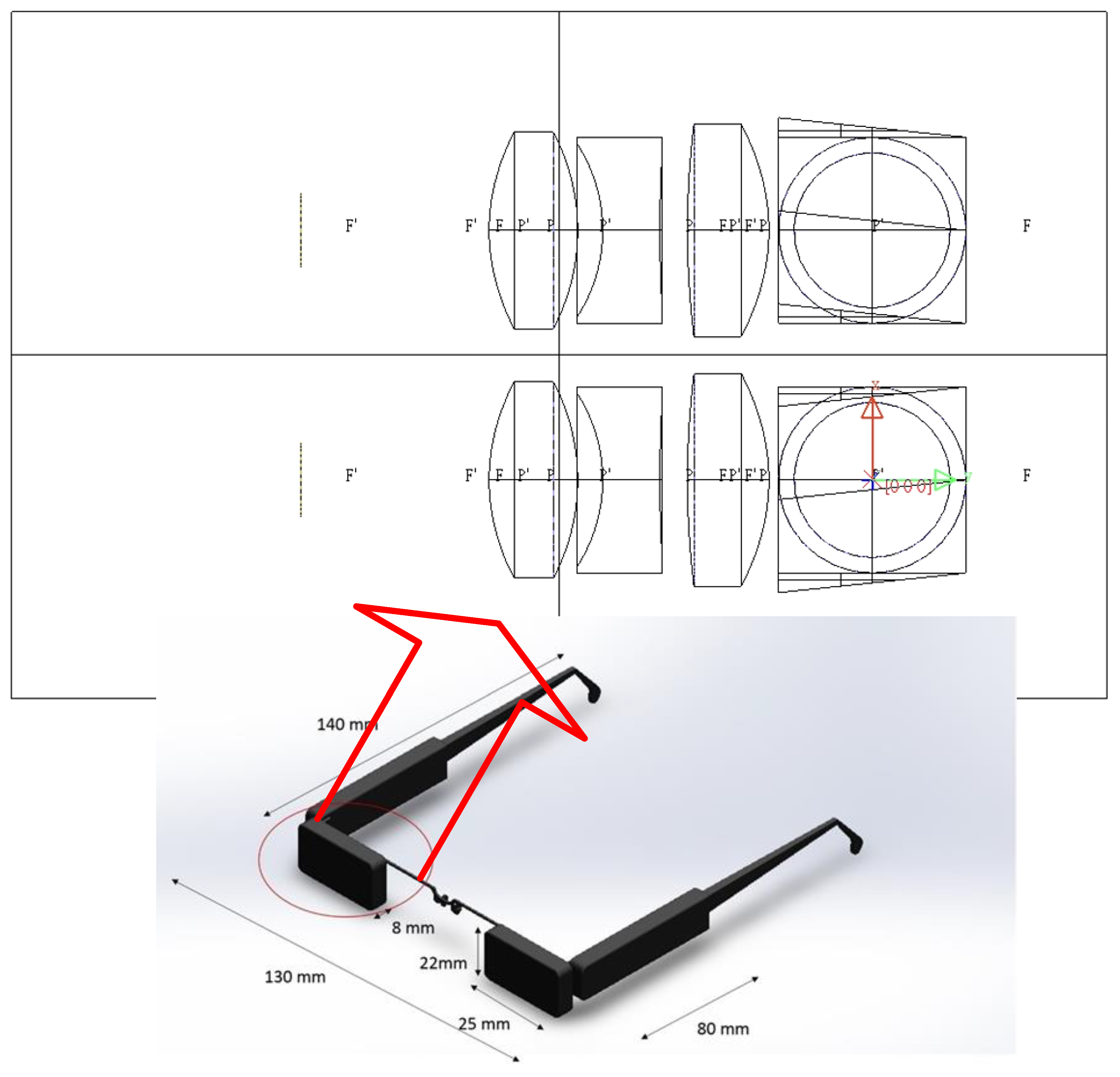Optical Design for Novel Glasses-Type 3D Wearable Ophthalmoscope
Abstract
:Featured Application
Abstract
1. Introduction
2. Image Recognition Experiment
2.1. Experimental Imaging Setting
2.2. Image Recognition Results
3. Glasses-Type 3D Ophthalmoscope Design
3.1. Optical Design for Glasses-Type 3D Ophthalmoscope Lens
3.2. Imaging Performance Assessment (Spots, Visual Field Diagrams, Aberrations, Modulation Transfer Function)
3.3. 3D Image-Taking Structure Design
4. Conclusions and Recommendations
- (1)
- Image recognition experiment: The 3D image recognition rate (90%) was higher than the 2D image recognition rate (84%); this reached obvious significance and, thus, the 3D mechanism design was selected.
- (2)
- A glasses-type 3D ophthalmoscope lens mechanism design: A wearable ophthalmoscope with 3D image-taking features and visible-infrared working spectrum was developed. These features are suitable for the diagnostic tracking of eye fundus’ imaging using a rotatable mechanism via a 3D optical structure design.
- (3)
- Ophthalmoscope lens design: Using imaging simulation technology, a set of ophthalmoscope lenses was designed to fit a glasses-type 3D ophthalmoscope; then, with the mechanism design, the specifications of wearable ophthalmoscope glasses were significantly reduced.
- (4)
- This proposed design and its mechanism can be connected with wireless networks, Bluetooth, or a cloud processing system in order to transfer the diagnostic images to the hospital and assist in the doctors’ diagnosis via cloud technology and big data statistics.
Author Contributions
Acknowledgments
Conflicts of Interest
References
- Meadway, A.; Girkin, C.A.; Zhang, Y.H. A dual-modal retinal imaging system with adaptive optics. Opt. Express 2013, 24, 29792–29807. [Google Scholar] [CrossRef] [PubMed]
- Felberer, F.; Kroisamer, J.S.; Hitzenberger, C.K.; Pircher, M. Lens based adaptive optics scanning laser ophthalmoscope. Opt. Express 2012, 16, 17297–17310. [Google Scholar] [CrossRef] [PubMed]
- Wu, B.W. Optical computing for application to reducing the thickness of high-power-composite lenses. Appl. Opt. 2014, 53, H7–H13. [Google Scholar] [CrossRef] [PubMed]
- Sun, J.H. Tolerance reallocation of an optical zoom lens to meet multiperformance criteria. Appl. Opt. 2014, 53, 233–238. [Google Scholar] [CrossRef] [PubMed]
- Fairhurst, A.M.; Lettington, A.H. The effect of visual perception on the required performance of imaging systems. J. Mod. Opt. 2000, 8, 1435–1446. [Google Scholar] [CrossRef]
- Fairhurst, A.M.; Lettington, A.H. Method of predicting the probability of human observers recognizing targets in simulated thermal images. Opt. Eng. 1998, 3, 744–751. [Google Scholar] [CrossRef]
- Wu, B.W.; Fang, Y.C.; Chang, L.S. Studies of Human Vision Recognition: Some Improvements. J. Mod. Opt. 2009, 57, 107–114. [Google Scholar] [CrossRef]
- Fang, Y.C.; Wu, B.W. Prediction of the Thermal Imaging Minimum Resolvable (Circle) Temperature Difference with Neural Network Application. IEEE Trans. Pattern Anal. Mach. Intell. 2008, 30, 2218–2228. [Google Scholar] [CrossRef] [PubMed]
- Yust, B.G.; Mimun, L.C.; Sardar, D.K. Optical absorption and scattering of bovine cornea, lens, and retina in the near-infrared region. Lasers Med. Sci. 2011, 2, 413–422. [Google Scholar] [CrossRef] [PubMed]
- Cohen, J. Statistical Power Analysis for the Behavioral Science; Academic Press: New York, NY, USA, 1977. [Google Scholar]
- Liu, R.Z. Stereo-Imaging Design for Flat-Screen. Master’s Thesis, Institute of Optical Sciences, National Central University, Taoyuan, Taiwan, 2001. [Google Scholar]









| Display Monitor | 3D Television | |
|---|---|---|
| Image type | 2D | 3D |
| Participant number | 20 people | |
| Display duration | 5 s per image | |
| Background illuminance | 10 cd | |
| Distance between eyes and screen | 250 cm | |
| Circular figure diameter | 50 cm | |
| round | vertical rectangle (1:3) | horizontal rectangle (3:1) |
 |  |  |
| triangle | Square | pentagon |
 |  |  |
| hexagon | ||
 |
| 2% | 4% | 6% |
 |  |  |
| 8% | 10% | 20% |
 |  |  |
| 0.9 | 1.1 | 1.2 |
 |  |  |
| 1.5 | 1.8 | 2.5 |
 |  |  |
| 3.7 | 5.4 | |
 |  |
| Image Type | N | M | SD | T (s) | p | η2 |
|---|---|---|---|---|---|---|
| 3D | 20 | 302.050 | 11.587 | 2.751 | 0.009 | 0.166 |
| 2D | 20 | 281.850 | 30.720 |
| Initial Conditions of Design | |
|---|---|
| Image Height | 2.4 mm |
| Source wavelength | Photonic 5 with 481, 546, 656, 965, 985 nm |
| Focal Length | 10 mm |
| Magnification | 2.5x |
| F/# | 2.0 |
| Overall Length | 20 mm |
| Optical Distortion | <3% |
| MTF | >20–40% (100 lp/mm) |
© 2019 by the authors. Licensee MDPI, Basel, Switzerland. This article is an open access article distributed under the terms and conditions of the Creative Commons Attribution (CC BY) license (http://creativecommons.org/licenses/by/4.0/).
Share and Cite
Tsai, C.-M.; King, T.-C.; Fang, Y.-C.; Hsueh, N.-W.; Lin, C.-W. Optical Design for Novel Glasses-Type 3D Wearable Ophthalmoscope. Appl. Sci. 2019, 9, 717. https://doi.org/10.3390/app9040717
Tsai C-M, King T-C, Fang Y-C, Hsueh N-W, Lin C-W. Optical Design for Novel Glasses-Type 3D Wearable Ophthalmoscope. Applied Sciences. 2019; 9(4):717. https://doi.org/10.3390/app9040717
Chicago/Turabian StyleTsai, Cheng-Mu, Tzu-Chyang King, Yi-Chin Fang, Nai-Wie Hsueh, and Che-Wei Lin. 2019. "Optical Design for Novel Glasses-Type 3D Wearable Ophthalmoscope" Applied Sciences 9, no. 4: 717. https://doi.org/10.3390/app9040717
APA StyleTsai, C.-M., King, T.-C., Fang, Y.-C., Hsueh, N.-W., & Lin, C.-W. (2019). Optical Design for Novel Glasses-Type 3D Wearable Ophthalmoscope. Applied Sciences, 9(4), 717. https://doi.org/10.3390/app9040717





